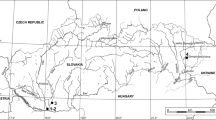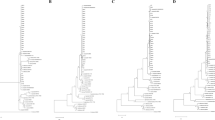Abstract
The marine-estuarine bacterium Vibrio harveyi is an important pathogen of invertebrates, most significantly, the larvae of commercially important shrimp Penaeus monodon. In this study, we analyzed V. harveyi isolated from shrimp hatchery environments for understanding the distribution of putative virulence genes and antimicrobial drug resistance. The putative genes targeted for PCR detection included four reversible toxin (Rtx)/hemolysin genes, a gene encoding homologue of Vibrio cholerae zonula occludens toxin (Zot) and a hemolysin-coregulated protein gene (hcp) by polymerase chain reaction (PCR). Of the four putative reversible toxin genes, vhh-1 was detected in 31% of the isolates, vhh-2 in 46%, vhh-3 in 23% and vhh-4 was detected in 27% of the isolates. A zot-like sequence of bacteriophage f237 was present in 15%, while hcp sequence was detected in 48% of the isolates. The antimicrobial susceptibility test revealed resistance to several groups of antibiotics including β-lactams, cephalosporins, macrolides, quinolones, nitrofurantoin and tetracycline.
Similar content being viewed by others
References
Lavilla-Pitogo CR, Baticados MCL, Cruz-Lacierda ER, De la Pena EL (1990) Occurrence of luminous bacterial disease of Penaeus monodon larvae in the Philippines. Aquaculture 91:1–13
Baticados MCL, Lavilla-Pitogo CR, Cruz-Lacierda ER, De la Pena LD, Sunaz NA (1991) Study on the chemical control of luminous bacteria Vibrio harveyi and Vibrio splendidus isolated from diseased Penaeus monodon larvae and rearing water. Dis Aquat Org 9:133–139
Abraham TJ, Palaniappan R (2004) Distribution of luminous bacteria in semi-intensive penaeid shrimp hatcheries of Tamil Nadu, India. Aquaculture 232:81–90
Alavandi SV, Manoranjita V, Vijayan KK, Kalaimani N, Santiago TC (2006) Phenotypic and molecular typing of Vibrio harveyi isolates and their pathogenicity to tiger shrimp larvae. Lett Appl Microbiol 43:566–570
Karunasagar I, Otta SK, Karunasagar I (1996) Biofilm formation by Vibrio harveyi on surfaces. Aquaculture 140:241–245
Austin B, Zhang XH (2006) Vibrio harveyi: a significant pathogen of marine vertebrates and invertebrates. Lett Appl Microbiol 43:119–124
Bassler B, Clifton SW, Fulton L, Delehaunty K, Fronick C, Harrison M, Markivic C, Fulton R, Tin-Wollam AM, Shah N, Pepin K, Nash W, Thiruvilangam P, Bhonagiri V, Waters C, Tu KC, Irgon J, Wilson RK (2008) The Vibrio harveyi genome sequencing project. http://genome.wustl.edu/genome.cgi?GENOME=Vibrio%20harveyi
Alsina M, Blanch AR (1994) A set of keys for biochemical identification of environmental Vibrio spp. J Appl Bacteriol 76:79–85
Fukui Y, Sawabe T (2007) Improved one-step colony PCR detection of Vibrio harveyi. Microbes Environ 22:1–10
Ausubel FM, Brent R, Kingsten RE, Moore DD, Seidman JG, Smith JA, Struhl K (1995) Short protocols in molecular biology, 3rd edn. John Wiley and Sons, New York
Clinical and Laboratory Standards Institute (CLSI) (2004) Performance standards for antimicrobial susceptibility testing: 14th Informational Supplements. NCaS document M 100-S14, Wayne
Altschul SF, Madden TL, Schaffer AA, Zhang J, Zhang Z, Miller W, Lipman DJ (1997) Gapped BLAST and PSI-BLAST: a new generation of protein database search programs. Nucleic Acids Res 25:3389–3402
Delepelaire P (2004) Type I secretion in gram-negative bacteria. Biochem Biophys Acta 1694:149–161
Glaser P, Ladant D, Sezer O, Pichot F, Ullmann A, Danchin A (1988) The calmodulin-sensitive adenylate cyclase of Bordetella pertussis: cloning and expression in Escherichia coli. Mol Microbiol 2:19–30
Bode W, Gomis-Rüth FX, Stöckler W (1993) Astacins, serralysins, snake venom and matrix metalloproteinases exhibit identical zinc-binding environments (HEXXHXXGXXH and Met-turn) and topologies and should be grouped into a common family, the ‘metzincins’. FEBS Lett 331:134–140
Higgins CF (1992) ABC transporters: from microorganisms to man. Ann Rev Cell Biol 8:67–113
Williams SG, Varcoe LT, Attridge SR, Manning PA (1996) Vibrio cholerae Hcp, a secreted protein coregulated with HlyA. Infect Immun 64:283–289
Bingle LE, Bailey CM, Pallen MJ (2008) Type VI secretion system: a beginner’s guide. Curr Microbiol 11:3–8
Waldor MK, Mekalanos JJ (1996) Lysogenic conversion by a filamentous phage encoding cholera toxin. Science 272:1910–1914
Fasano A, Fiorentini C, Donelli G, Uzzau S, Kaper JB, Margaretten K, Ding X, Guandalini S, Comstock L, Goldblum SE (1995) Zonula occludens toxin modulates tight junctions through protein kinase C-dependent actin reorganization, in vitro. J Clin Invest 96:710–720
Kurazono H, Pal A, Bag PK, Nair GB, Karasawa T, Mihara T, Takeda Y (1995) Distribution of genes encoding cholera toxin, zonula occludens toxin, accessory cholera toxin and El Tor haemolysin in Vibrio cholerae of diverse origins. Microb Pathog 18:231–235
Walsh C (2000) Molecular mechanisms that confer antibacterial drug resistance. Nature 406:775–781
Teo JW, Suwanto A, Poh CL (2000) Novel β-lactamase genes from two environmental isolates of Vibrio harveyi. Antimicrob Agents Chemother 44:1309–1314
Teo JW, Tan TM, Poh CL (2002) Genetic determinants of tetracycline resistance in Vibrio harveyi. Antimicrob Agents Chemother 46:1038–1045
Acknowledgments
The authors are grateful to the Director, NIO, Goa and the Scientist- in- charge, NIO (RC), Cochin for their support and advice. Financial support from suprainstitutional project SIP 1302 is gratefully acknowledged. The authors thank Dr. Sanath Kumar, ENMU, USA for valuable suggestions and critical reading of the manuscript. Assistance by Mr. Kiran Krishna, Junior technical assistant, NIO (RC), Cochin is acknowledged. This is NIO contribution number 4559.
Author information
Authors and Affiliations
Corresponding author
Rights and permissions
About this article
Cite this article
Parvathi, A., Mendez, D. & Anto, C. Distribution of Putative Virulence Genes and Antimicrobial Drug Resistance in Vibrio harveyi . Indian J Microbiol 51, 332–337 (2011). https://doi.org/10.1007/s12088-011-0128-z
Received:
Accepted:
Published:
Issue Date:
DOI: https://doi.org/10.1007/s12088-011-0128-z




